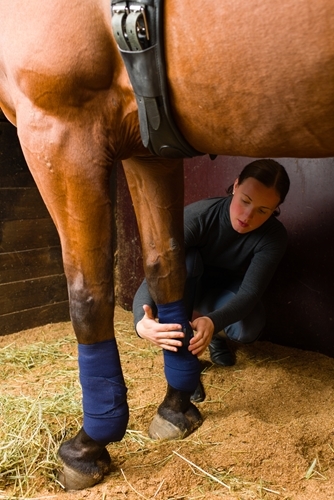In its racing career, a horse goes through ups and downs, wins and losses. Though equine trainers strive to keep their animals as healthy, strong and fit as possible, minor stiffness/soreness can happen. Much of the physical movement revolves around a horse’s legs – they don’t call it legwork for nothing. To help promote healthy equine exercise recovery, many trainers apply poultices for the temporary relief of minor stiffness and soreness due to overexertion. Poultices are commonly used after workouts and competitions.
The word poultice may be originally derived from a Latin word puls, meaning porridge. The health technique is predominantly used on the lower legs of horses to help promote healthy tendons, joints and ligaments. The goal is to reduce minor inflammation from physical exertion.
Typically, poultices consist of clays such as montmorillonites and aluminum silicates. Formulas vary from plain, to including essential oils and/or herbal or other components. To hold the poultices in place, you’ll need bandages that go around a horse’s legs. A scissor, tape and gauze are also necessary. Consult your vet before applying this treatment, or if you are unsure how to do it.
Hot or cold?
Whereas hot poultices draw, cold poultices relieve minor inflammation. Even though horse trainers might prefer one over the other, there can be benefits to each.
“Through time, a lot of veterinarians and horsemen out there have gone back and forth between hot and cold, trying to get the best out of each,” Dr. Earl Gaughan, DVM, Diplomate ACVS, associate professor of equine surgery at Auburn University’s College of Veterinary Medicine, told HorseChannel.com. “I can’t argue with this, as sometimes a horse benefits from a little bit of both.”
A general rule is that cold treatments are best applied for recent events and as preventive therapy after racing or workouts. It tends to work most effectively in the early acute phases following minor soreness, Gaughan added. By limiting blood flow to the localized area, cold minimizes minor discomfort.
The cold clay should be placed in plastic bag in the freezer for about a half an hour. Prior to putting the poultice on the horse’s leg, be sure to clean the leg thoroughly, then wet each one with either warm or cold water. Then apply the poultice and bandage the legs. Remove the bandage within 24 hours. For hot clay poultice, put the amount of poultice needed in a plastic bag and heat it in the microwave. Be careful to avoid overheating, or freezing the poultice.
Horse owners interested in poultice products should research Finish Line’s Kool-Out™, Original Premium and EZ Willow poultices.
WATCH THE VIDEO HERE>
https://www.youtube.com/watch?v=1q9cwpD-JL8&t=4s








